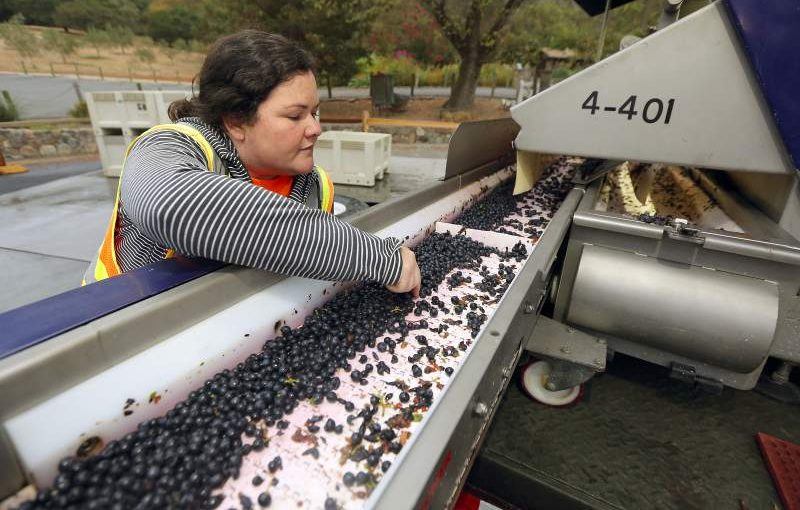
Perhaps no agricultural crop has been more associated with the work in the fields than the grape. From the Bible to John Steinbeck to Cesar Chavez, the words and images of workers toiling in the vineyards have been ingrained in literature, newsreels and history books.
It’s also a common sight throughout the year in Wine Country, from workers pruning vines in the winter to early morning harvests in the fall. Sonoma County vintners employ an estimated 5,000 people in the fields.
Increasingly, however, machines are taking over. It’s not a science fiction takeover plot, though the lights emanating from machine harvesters at night in areas such as the Alexander Valley resemble the glowing spaceships in “Close Encounters of the Third Kind.” Rather, a tipping point has been reached in the industry, growers said, as technology advances along with a labor shortage. New regulations have driven most vineyard owners and managers to consider more machine picking with the likelihood that the workforce in future years will be much smaller.
“You are going to see more and more,” said Bret Munselle of Munselle Vineyards, which oversees about 600 acres around Alexander Valley. “With labor and water issues, you are trying to get as much machine work as can be done.”
After years of a tight labor market as a result of decreased immigration, growers have been searching for new options. Now they have even more incentives for machine work, farmers contend, with new state laws bumping the minimum wage up to $15 an hour and another requiring that farmworkers get paid overtime after working 40 hours a week or more than eight hours a day. The current standard is 10 hours a day or 60 hours a week for agricultural workers.
“They’re going to do anything that has the potential of relieving some of the pressure of labor accessibility,” said Duff Bevill, of Bevill Vineyard Management in Healdsburg. His company set a record for number of machine harvests this season, using them at least six nights a week for the past six weeks.
The wine grape industry has historically lacked in machine use compared to other agriculture crops, noted Damien Wilson, the Hamel Family Chair in Wine Business at Sonoma State University.
One problem has been the vast number of wineries — there are about 9,500 in North America — compared to other crops that are dominated by a few major corporations, which can implement change much more quickly, Wilson said.
“With such a large number of small producers, initiating change just takes a long time,” he said.
In addition, some smaller vintners and growers, especially in the high-end areas such as Sonoma and Napa counties, may not feel they need to jump on new technology to survive. They have an attitude of “we are in completely and totally different markets so we don’t have to adopt,” Wilson said.
Still, change is coming. More winemakers are starting to believe that machine-picked grapes can deliver as high a quality as those that are hand picked, an idea that historically was met with skepticism. In fact, winemaker reluctance has been one of the biggest barriers given their power in the industry.
“There isn’t another (agriculture) industry like this that inspects the vineyard and tells them what to do,” said Mark Greenspan of Advanced Viticulture Inc., which provides technology to reduce the amount of water used during irrigation.
Research on the topic is in its infancy, though UC Davis already has a faculty member doing comparisons of grapes that are harvested by machines compared to those that are hand-picked.
Bevill noted that he machine-picked a block of sauvignon blanc for a skeptical client three years ago and he became a believer after the considerably chilled fruit showed up at the crush pad right at 5 a.m. “Now they are perfectly happy with it,” he said.
It can be seen over at Gundlach Bundschu Winery in Sonoma, which for the past six harvests has used a machine that optically sorts grapes before they reach the crush pad. The machine can kick out up to 4 percent of the grapes that are hauled in from the vineyard, after they have already been put through a destemming machine. The grapes travel at high speed through the machine, where a computer takes a rapid-fire snapshot of the berries, and sorts them out through compressed air into a “good” bin and a “bad” bin.
The rejects are those that are raisin-like, small green berries, have poor color or are an awkward shape. The good ones are then crushed into a must that will be eventually turned into a reserve cabernet that can sell for as much as $125 a bottle.
Anne Dempsey, the winemaker at Gundlach Bundschu, has become a convert.
“You just stand back and let it shine,” Dempsey said as she supervised the sorting on Sept. 29. “It’s fantastic to be able to work with fruit. . . . It makes my job a lot easier.”
In the traditional method, Dempsey said, she would have to do more manipulation with the wine, such as pumping the red juice from the bottom to the top of the tank. The procedure helps submerge the grape skins.
Heat spike kicks North Coast grape harvest into high gear
“While you can still make a great wine the other way, you have to do the work in the process,” Dempsey said. “Here’s it’s a mechanical assist. . . . It allows me to be an artist as opposed to a technician.”
Gundlach Bundschu has conducted its own taste tests on wine made from grapes that go through the optical sorting machine compared to bottles made from grapes that didn’t go through the device. Dempsey noted that the treated wine brings out “the clarity of the fruit and the flavor. . . . The flavors come very early.” Proponents also say the color of the machine-sorted wine also looks brighter.
Besides the taste, the machines also are more productive. While the optical sorter could sort 30 tons a day, a crew sorting grapes by hand would only be able to sort about 10 tons, Dempsey said.
“The disadvantage of hand sorting is after a while, people’s eyes get tired,” she said.
New technologies have also brought more environmentally friendly practices to winemaking. For example, Jackson Family Wines, which has been a leader of innovation in the industry, worked with the Tom Beard Co. in Santa Rosa to design a barrel washing line that reuses water up to three times before it’s sent into the drain, saving 700,000 gallons of water annually.
Ed Barr, president of Tom Beard, said he has had many requests about his barrel washing lines from vintners looking to be more efficient. Barr noted the technology has been around since 1984, but has become more refined through the years — it can now do up to 3,000 barrels a day. That has allowed its price to drop to make it more affordable for smaller vintners as well.
The machine technology in the winery may not result in such large scale job loss as that in the vineyards, Barr said, but it has allowed cellar workers to become much more productive. For instance, his company offers a device that emits ultraviolet light to help sanitize tanks, saving tremendous time compared to more traditional cleaning methods. “They can be doing other things,” he said of the cellar workers.
The vineyard, however, represents the greatest potential for change, especially as the technology has gotten better. Sensors can more strategically locate leaves while missing the fruit during leaf removal. Tractors also now have more horsepower to carry various attachments.
The manufacturer of the optical sorting machine used at Gundlach Bundschu, Pellenc, a French-based company with a Santa Rosa office, has other machines that can do almost everything in the vineyard. It sells machines that can be attached to tractors and harvest grapes — shaking the vines vigorously to loosen the clusters that fall into bins. It also has machines that can do leaf removal, spraying (including multiple rows at once) and some pruning.
The only major task that Pellenc machines have not mastered is shoot thinning, which helps target the overall number of clusters to be harvested in the fall and opens up canopies to prevent mildew and other problems, said John Felice, a Pellenc sales representative for the North Coast.
The investments can be significant. Bevill said a machine harvester can cost from $250,000 to $500,000. But Felice notes that in his pitch to vineyard managers — those who oversee at least 150 acres or more — that they can save up to a third of the cost versus using laborers in the first year of machine use.
“We provide farming solutions to lower your risk and increase profitably,” Felice said.
Even with the trend, there will still be a need for vineyard pickers, growers said, noting that hillside rows cannot be picked by machine. There will also be a need for workers who can operate and use the tractors and the various attachments, with those jobs carrying a higher salary than those who pick. But those jobs will not be as plentiful.
When vineyards are replanted, now they are typically laid out so they accommodate tractors. The trellis systems are calibrated so that the various attachments can be used with them.
“They are sort of targeted to have no footprints in the vineyard,” Bevill said of the new layouts.
